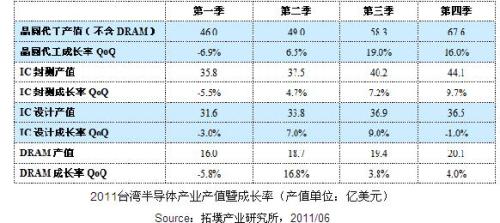 COMPUTEX 2011 announces that the mobile terminal year has already come. Takubo Industry Research Institute predicts that the mobile terminal will hit. In 2011, the global semiconductor industry output will reach US$315 billion, with an annual growth rate of 5.6%. Taiwan wafer foundry and packaging and testing industry benefited from high-end process advantages such as dual-core processors. Though 2011 is expected to grow by more than 10%, IC design and DRAM industry are not subject to post-PC transformation and high debt ratio drag process respectively. Pushing speed, both show decline. Therefore, Takuma estimated that the output value of Taiwan's semiconductor industry in 2011 was $59.14 billion, and the growth rate was 4.8% lower than the global average.
COMPUTEX 2011 announces that the mobile terminal year has already come. Takubo Industry Research Institute predicts that the mobile terminal will hit. In 2011, the global semiconductor industry output will reach US$315 billion, with an annual growth rate of 5.6%. Taiwan wafer foundry and packaging and testing industry benefited from high-end process advantages such as dual-core processors. Though 2011 is expected to grow by more than 10%, IC design and DRAM industry are not subject to post-PC transformation and high debt ratio drag process respectively. Pushing speed, both show decline. Therefore, Takuma estimated that the output value of Taiwan's semiconductor industry in 2011 was $59.14 billion, and the growth rate was 4.8% lower than the global average. OEM foundry and IC design, DRAM sluggish outlook Taiwan's semiconductor industry in the second half of 2011 performance, the same sadness and joy. Regardless of second-generation smart phones such as the HTC Sensation and the Samsung GALAXY SII, or the iPad 2 and the next-generation iPhone, multi-core mobile processors and 768MB to 1GB of removable memory have become mainstream specifications. The dual-core processor is mainly manufactured on a 45-nanometer process. Except that the Apple processor is manufactured by Samsung, other high-end processes are mostly OEMs. Topo predicts that with the increase in the proportion of high-end wafer processing in the second half of 2011, Taiwan's foundry industry (excluding DRAM) is expected to grow by more than 10% in the third and fourth quarters. The demand for smart mobile devices to drive high-density packaging, coupled with the effect of the 311 earthquake in Japan, is the third largest in the IC packaging and testing industry in Taiwan, and will grow at more than 7% in the four seasons.
In contrast, the IC design industry in Taiwan was constrained by the slowdown in the growth of PCs and mainland cottages, coupled with the inability to timely respond to the explosive demand of global tablets and smart phones, and the output value hit bottom in the first quarter of 2011, and picked up gradually from the second quarter. It is expected to grow 9% in the third quarter and the fourth quarter will be slightly back to 1% compared to the third quarter. In the second half of the year, DRAM resumed its normal decline. As a result, the Taiwan Plant increased its grain growth compared with the international manufacturers, and its revenue performance in the second half of the year will also be better than that in the first half of the year. Even if IC design and DRAM performance are growing in the second half of the year, overall, the whole Annual performance still holds a recessionary trend (pictured).
Looking at the current mainstream of smart phone camera module 300 to 500 pixels, it is close to the pixel limit that FSI CIS minimum pixel size (1.75um) can provide. Therefore, the mainstream of smart phone camera module in the second half of 2011 will go to 8 million pixels or even 10 million. Pixel advancement will inevitably use the Backside Illumination (BSI) architecture of image sensing components.
Topo predicts that in 2010, the penetration rate of BSI CIS (CMOS Image Sensor) in the smartphone market will be approximately 20%, with an output value of US$700 million. The estimated production value in 2014 will be significantly increased to US$4.5 billion, and the market share will exceed 9 percent. Into the growth will be more than 6 times. TSMC has actively expanded its production capacity. In response to the huge demand, Taiwan's downstream packaging and testing industry and cleanroom manufacturers will benefit, becoming TSMC's manufacturing supply chain member in BSI CIS.
Consumers' mobile Internet usage patterns have established global demand for terminal products such as tablets and smartphones. Takuya expects that mobile terminals will focus on power saving and dual-core development in the second half of 2011, and the demand for image sensing components will increase. Whether it is foundry, IC design, IC packaging and testing, or even memory and control ICs based on the increased demand for mobile DRAM and NAND Flash, all of Taiwan's semiconductor industry can speed up the layout, or take advantage of opportunities for transformation and recycling opportunities. Only manufacturers must discard the blind pursuit of a large number of low-cost single-product production model, high-end process and power-saving technology development, is to grab the global hot product supply chain, to ensure long-term operating performance.
Connecting Terminals,Micro Connecting Terminal,Aluminum Connecting Terminals,Connecting Copper Terminal
Taixing Longyi Terminals Co.,Ltd. , https://www.longyiterminals.com
